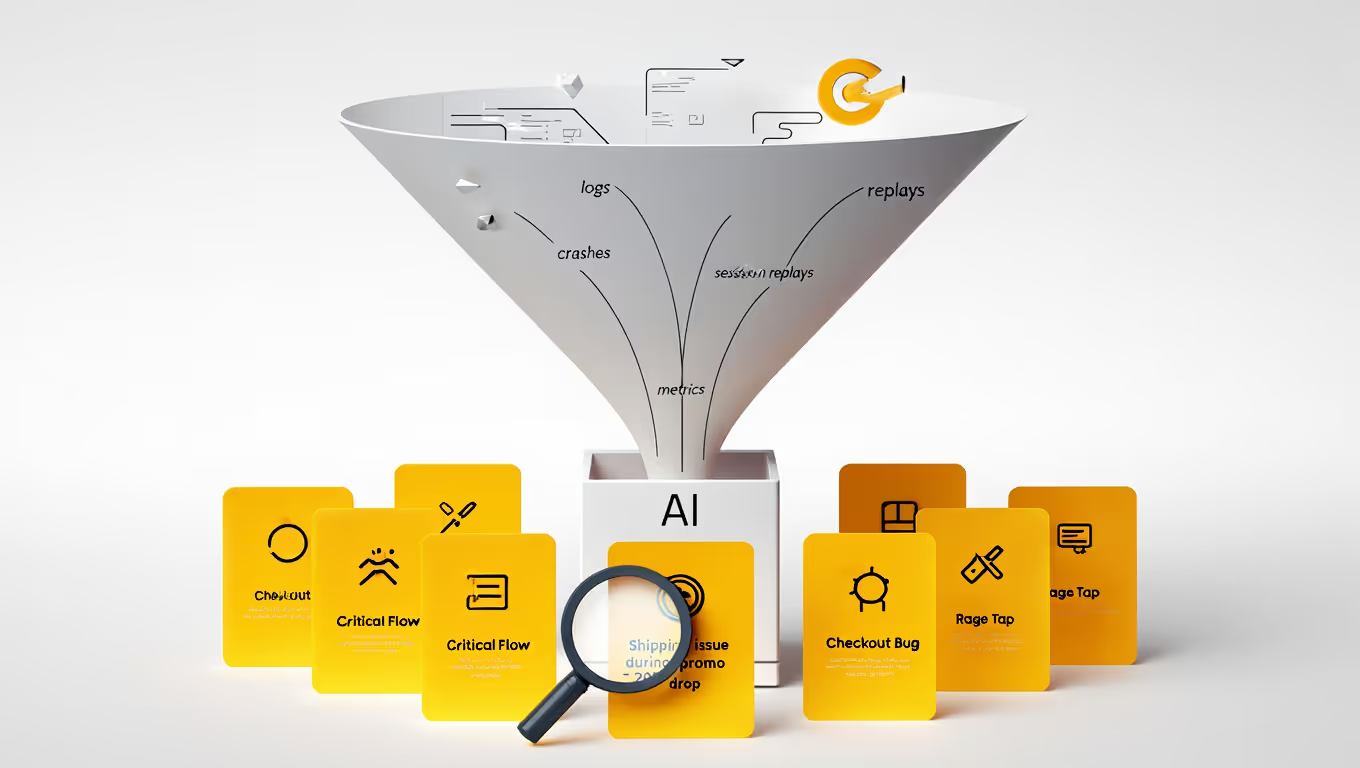When you debug an app today, you're not really debugging code. You are debugging behavior. Behavior of users, systems, networks, even the code itself, interacting in ways you didn’t anticipate. And in mobile, where everything is opaque and messy, that gets 10x worse.
That’s why AI is going to eat mobile debugging. Not because it’s trendy, but because it’s the only thing that scales. You can’t manually sift through a million sessions. You can’t trace subtle regressions across five app versions. You definitely can’t correlate backend timeouts to rage taps. But AI can. Not perfectly, but better than a tired engineer on hour 12 of log diving.
Here’s what that looks like.
1. You Don’t Need All the Data. Just the Right 10 Sessions.

Every app has a firehose of telemetry. Crashes, replays, clicks, logs, metrics. What you actually want is an oracle to tell you: “Look at these 10 sessions. This is where things broke in a way that matters.”
AI can rank sessions not just by severity, but by intent and impact. It can know the difference between a random crash on a jailbroken phone, and a failure on the checkout screen during a major promo.
Example: In one D2C home decor app, AI surfaced a weird pattern, users bouncing between product images and the cart. Turns out they were hunting for shipping costs that only showed up at the final step. The result? A 20% drop in conversions. No amount of manual log inspection would’ve caught that.
2. Debugging Is Just Root Cause Analysis at Scale
Crashes are symptoms. The real problem is figuring out why they happen. In old debugging, you start with the stack trace. In the new world, AI starts with the outcome and works backward: UI flow → API calls → backend anomalies.
That’s an engineer who never sleeps and never forgets a pattern.
Example: One high-end electronics brand saw their app ratings tanking. AI traced it to inconsistent discount logic, two backend systems sending conflicting promo rules. Users couldn’t check out. No crash, just confusion and drop-offs.
3. Regression Detection Is Just QA That Never Clocks Out
QA doesn’t scale post-release. AI does. It watches usage patterns and flags things like:
- A button that suddenly disappears on certain screen sizes
- A feature that’s getting zero engagement after the last deploy
- An animation that’s now 300ms slower and annoying users just enough to make them leave
Example: A D2C mattress company launched a new layout. AI noticed referrals dropped 15%. Why? The “Share” button got pushed below the fold. No human noticed.
This is continuous QA, except it’s in production, and it actually works.
4. Error Logs Don’t Matter. Root Causes Do.
Most mobile apps drown in stack traces. One error can show up 50 different ways depending on device, OS, or user flow.
AI can cluster these into two things that actually matter.
Example: A meal delivery app had 3,000 unique error logs on checkout. AI grouped them into two causes: a UI library bug and a payment timeout. That’s the difference between noise and signal. Difference between fixing it tomorrow or next month.
5. AI Isn’t Just Watching. It’s Predicting.
The best debugging doesn’t start when things break. It starts before.
AI can tell you:
- This API is slowing down and will cause a spike in support tickets tomorrow=
- Users on Android 12 are about to churn because of a hidden UI bug
- Your latest deploy just broke a flow that matters to your top-paying segment
Example: A wellness app saw trial conversions nosedive. AI found the CTA on the subscription screen was clipped on some Android phones. No bug report. Just silent failure. Caught and fixed, because AI was watching.
6. Dashboards That Don’t Suck
Most dashboards are one-size-fits-none. AI can tailor them to roles:
- Frontend devs see UI breakpoints and user replays
- Backend devs see failing endpoints
- PMs see revenue-impacting flows
Example: In one baby products app, PMs got an alert: add-to-cart success had dipped below 60% for users on 3G. That wasn’t in the logs. It was in the patterns. And AI saw it.
Conclusion: AI Isn’t “Nice to Have.” It’s the Debug Sidekick.

Most people think of AI in mobile as something extra. A nice-to-have. That’s a mistake.
AI is not an add-on to debugging. It is debugging.
Because the future of mobile apps is messy. More devices, more flows, more edge cases. You won’t be able to keep up by adding more QA engineers or staring harder at dashboards. The only way to stay ahead is to have something watching everything, learning constantly, and telling you what matters.
That’s not just helpful. It’s existential.
If you’re building a serious mobile product, you either figure this out, or get left behind by someone who already has.
That’s the landscape now.
Mobile debugging has evolved from inspecting code to decoding behavior. From stack traces to cause chains. From crashes to subtle UX decay. You don’t just fix bugs anymore. You fix entire experiences, or you lose users who never tell you why they left.
So what do you do?
You can keep building brittle chains of observability tools, log scrapers, crash reporters, and dashboards. But that’s like stitching together a Frankenstein when what you really need is a system that watches everything, understands what matters, and points to the root cause without asking you to be a detective.
In other words: debugging now demands AI.
Not because it’s trendy. Because it’s the only thing that scales.
So We Built Oopsie
That’s the problem we were staring at when we built Oopsie, part of the Zipy platform.
Not a better dashboard.
Not just another crash reporter.
But an AI-native debugging assistant that understands modern mobile apps the way engineers do, but faster, and without burning out.
Because when a layout change tanks conversions, or an ANR pops up on only one Android version, or a button silently disappears after a deploy, logs won’t save you. But replaying the exact session will. And seeing the network logs, UI flow, and AI-summarized root cause in one place? That’ll save your next sprint.
Here’s What It Does and Why It Matters

Mobile Session Replays That Actually Matter
Every session is captured. But only the ones that show unusual behavior get flagged. AI watches what users did, what changed, and what failed, so you don’t have to filter through noise.
It’s like having a million test cases running in production, except they’re your real users, and the AI is telling you which ones broke something that matters.
Oopsie Bugs: UI Breakage Without the Crash
Crashes get attention. But most users don’t crash, they just give up.
Oopsie catches visual issues and interaction failures: clipped buttons, misaligned elements, flows that dead-end. These are the silent killers of retention. Oopsie turns them into video snippets with logs and impact attached.
No guesswork. No "couldn’t repro." Just watch and fix.
AI-Powered Summaries and Repro Steps
Engineers shouldn’t spend hours reconstructing bug reports. Oopsie does it for you, summarizing what the user did, what broke, and exactly how to reproduce it. One click. One path. No back-and-forth with QA.
Built-In Firebase Crashlytics Integration
If you're already using Firebase, Oopsie enhances it. Every crash and ANR links back to full session replays with context, no more correlating symbols with guesswork.
If you’re serious about mobile, you already know the surface-level tooling isn’t enough anymore.
The app landscape is exploding with device variants, OS quirks, connectivity gaps, and user behaviors that don’t show up in test cases. The result? A debugging problem that outscales any human-only solution.
The answer isn’t throwing more engineers at logs. It’s building systems that see and think faster than humans can. Systems that:
- Watch real usage
- Spot invisible regressions
- And explain bugs like a senior engineer
That system is Oopsie. Not a tool you might need. A tool you’re going to need either now, or after enough production fire drills force your hand.
We didn’t build Oopsie because it sounded cool.
We built it because debugging mobile the old way was breaking us.
Now, it’s fixing that for everyone else too.
.svg)







.avif)



.webp)